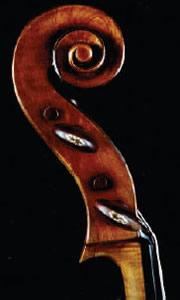 The secret to a smooth sound may lie in boiling the wood with salts.
The secret to a smooth sound may lie in boiling the wood with salts.Simple pest control techniques may have given rise to the greatest violins ever made. Biochemists say the key to the instrument's sweet sounds come not only from their construction but also from chemicals used to treat wood.
For hundreds of years people have tried to duplicate the tone of Italian violins such as a Stradivari and a Guarneri. Now scientists say at least part of the secret is to boil the wood in minerals.
A team of scientists lead by Joseph Nagyvary of Texas A&M University, College Station, used nuclear magnetic resonance and infrared spectroscopy to analyse the chemical makeup of wood in antique and modern-day instruments.
Slivers of the wood used to make modern violins were compared with the shavings of five antique instruments from the 1700s. Included in the mix were a Stradivari violin and cello, a Guarneri violin, a Gand & Bernardel violin from Paris and a Henry Jay viola from London.
Pest control
The results show that molecules of hemicellulose (short-chained polymers of sugar found in the cell walls of wood along with cellulose and lignin) in the Stradivari and Guarneri instruments had broken down — an effect of chemical reactions such as oxidation and hydrolysis.
That could, in some cases, be a result of natural aging of the woods. But Nagyvary says the most likely explanation is that the wood was chemically treated. Oxidizing agents such as salt or copper, for example, could have been used to protect the wood from pests.
"What we can see is the result of elaborate wood treatment," says Nagyvary. "Woodworm and fungus were significant problems for the craftsman. They probably boiled the wood in a brine that contained various minerals to exterminate infestations." Exactly what chemical recipes were used is unknown.
The end result? Wood that is harder, lighter and produces a smoother sound.
Fiddling with wood
Researchers, musicians and craftsmen have attributed the striking quality of tone from antique instruments to everything from the high density of the wood used (thanks to climate conditions that led to slow tree growth during a certain period of history) to the way the wood was heat-treated, or even some unknown property of the varnish.
"There is a lot of muck and magic about this type of thing," says Julian Vincent, a biomimetics specialist at Bath University in the UK. He says Nagyvary's work looks sound, but it is hard to know if his theory is right without taking two pieces of the exact wood used by Stradivari, treating one and not the other, and comparing the sound of the instruments produced.
ADVERTISEMENT
Nagyvary hasn't quite done that, but he has made a violin using a chemical treatment similar to the one he supposes was used in the past (he keeps his exact recipe secret). At a recent meeting of the Japan Society of Applied Physics in Tokyo, his violins were praised by professional musicians.
Valued at up to $10 million each, Stradivari violins are few and far between. With only about 600 remaining today, it is difficult to get wood to study.
Nagyvary's team plan to burn what little wood they have to work out its mineral composition. They won't have these results until next year.
Visit our keytostradivaristone.html">newsblog to read and post comments about this story.
-
References
- Nagyvary j., DiVerdi j. a., Owen N. L.& Dennis Tolley H., . Nature, 444 . 565 (2006). | Article |
